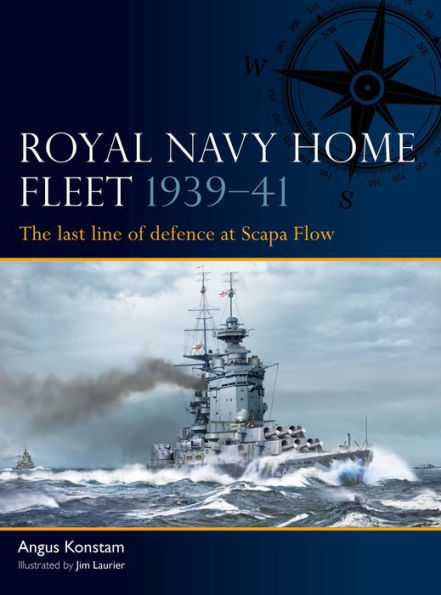Packed with illustrations, this is a new history and analysis of how the Royal Navy's most important fleet operated and fought the German Navy in the crucial first years of World War II.
Throughout its history, the Royal Navy's most powerful fleet has been the one guarding home waters. In this book, naval historian Angus Konstam explores the fighting power, the roles, and the battles of the Home Fleet, in the crucial first years of World War II when it was Britain's most powerful fighting force, anchored in the northern bastion of Scapa Flow.
He explains the complex responsibilities of the fleet, charged simultaneously with preventing the powerful German Navy from breaking out into the Atlantic; preparing to challenge any cross-Channel invasion force; and attacking German naval operations in the North Sea. Home Fleet actions included the loss of HMS Hood, the sinking of the Bismarck and countering the invasion of Norway, Germany's biggest amphibious operation of the war.
Packed with striking new artwork and 3D diagrams and maps, this book offers a detailed portrait of the Home Fleet during these most crucial years of the war, from the capabilities of the warships to logistics and intelligence-gathering, to how the fleet was organized and commanded, and how and why it fought as it did.
"1143331050"
Throughout its history, the Royal Navy's most powerful fleet has been the one guarding home waters. In this book, naval historian Angus Konstam explores the fighting power, the roles, and the battles of the Home Fleet, in the crucial first years of World War II when it was Britain's most powerful fighting force, anchored in the northern bastion of Scapa Flow.
He explains the complex responsibilities of the fleet, charged simultaneously with preventing the powerful German Navy from breaking out into the Atlantic; preparing to challenge any cross-Channel invasion force; and attacking German naval operations in the North Sea. Home Fleet actions included the loss of HMS Hood, the sinking of the Bismarck and countering the invasion of Norway, Germany's biggest amphibious operation of the war.
Packed with striking new artwork and 3D diagrams and maps, this book offers a detailed portrait of the Home Fleet during these most crucial years of the war, from the capabilities of the warships to logistics and intelligence-gathering, to how the fleet was organized and commanded, and how and why it fought as it did.
Royal Navy Home Fleet 1939-41: The last line of defence at Scapa Flow
Packed with illustrations, this is a new history and analysis of how the Royal Navy's most important fleet operated and fought the German Navy in the crucial first years of World War II.
Throughout its history, the Royal Navy's most powerful fleet has been the one guarding home waters. In this book, naval historian Angus Konstam explores the fighting power, the roles, and the battles of the Home Fleet, in the crucial first years of World War II when it was Britain's most powerful fighting force, anchored in the northern bastion of Scapa Flow.
He explains the complex responsibilities of the fleet, charged simultaneously with preventing the powerful German Navy from breaking out into the Atlantic; preparing to challenge any cross-Channel invasion force; and attacking German naval operations in the North Sea. Home Fleet actions included the loss of HMS Hood, the sinking of the Bismarck and countering the invasion of Norway, Germany's biggest amphibious operation of the war.
Packed with striking new artwork and 3D diagrams and maps, this book offers a detailed portrait of the Home Fleet during these most crucial years of the war, from the capabilities of the warships to logistics and intelligence-gathering, to how the fleet was organized and commanded, and how and why it fought as it did.
Throughout its history, the Royal Navy's most powerful fleet has been the one guarding home waters. In this book, naval historian Angus Konstam explores the fighting power, the roles, and the battles of the Home Fleet, in the crucial first years of World War II when it was Britain's most powerful fighting force, anchored in the northern bastion of Scapa Flow.
He explains the complex responsibilities of the fleet, charged simultaneously with preventing the powerful German Navy from breaking out into the Atlantic; preparing to challenge any cross-Channel invasion force; and attacking German naval operations in the North Sea. Home Fleet actions included the loss of HMS Hood, the sinking of the Bismarck and countering the invasion of Norway, Germany's biggest amphibious operation of the war.
Packed with striking new artwork and 3D diagrams and maps, this book offers a detailed portrait of the Home Fleet during these most crucial years of the war, from the capabilities of the warships to logistics and intelligence-gathering, to how the fleet was organized and commanded, and how and why it fought as it did.
13.99
In Stock
5
1

Royal Navy Home Fleet 1939-41: The last line of defence at Scapa Flow
80
Royal Navy Home Fleet 1939-41: The last line of defence at Scapa Flow
80eBook
$13.99
$18.40
Save 24%
Current price is $13.99, Original price is $18.4. You Save 24%.
Related collections and offers
13.99
In Stock

Product Details
| ISBN-13: | 9781472861450 |
|---|---|
| Publisher: | Bloomsbury Publishing |
| Publication date: | 03/28/2024 |
| Series: | Fleet , #5 |
| Sold by: | Barnes & Noble |
| Format: | eBook |
| Pages: | 80 |
| File size: | 10 MB |
About the Author
From the B&N Reads Blog
